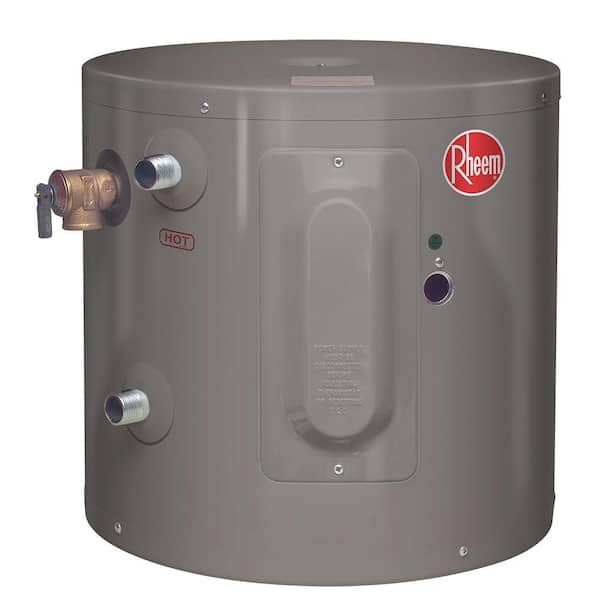Understanding 6-Gallon Electric Hot Water Heaters
A 6-gallon electric hot water heater is a compact, electrically powered appliance designed to heat and store a small volume of water. These units are typically favored for point-of-use applications or situations with low hot water demand.
Key Characteristics and Specifications
Understanding the typical features of a 6-gallon electric water heater is crucial for determining its suitability:
- Capacity: Stores approximately 6 US gallons (around 22.7 liters) of hot water.
- Power Source: Operates on electricity, commonly requiring a dedicated circuit. Voltage is typically 120V for smaller units, though 240V models exist.
- Heating Element: Usually equipped with a single immersion-type heating element. Wattage can vary, often between 1,440W to 2,500W depending on voltage.
- Recovery Rate: This indicates how many gallons of water the unit can heat by a certain temperature rise (e.g., 90°F or 50°C) in one hour. For a 6-gallon unit, this might be in the range of 6 to 12 gallons per hour (GPH) depending on element wattage and incoming water temperature.
- Energy Factor (EF) or Uniform Energy Factor (UEF): While smaller units might not always have the highest UEF ratings compared to larger, more advanced models, their point-of-use nature can reduce standby losses from long pipe runs. Look for Energy Star certification where applicable.
- Dimensions & Weight: Designed to be compact for installation in tight spaces like under counters, in closets, or in utility rooms. Typically lightweight before filling.
- Tank Material: Often features a glass-lined steel tank to prevent corrosion, along with an anode rod for further protection.
- Thermostat: Equipped with an adjustable thermostat to control water temperature, usually with a high-limit safety shut-off.
- Pressure and Temperature Relief Valve (T&P Valve): A mandatory safety device that releases pressure or excessively hot water.
Common Applications
The limited capacity of a 6-gallon electric water heater makes it ideal for specific scenarios:

- Point-of-Use (POU): Supplying hot water to a single fixture like a remote sink, a small shower, or a utility basin, minimizing wait time and energy loss through pipes.
- Small Apartments or Studios: Can serve as the primary water heater where demand is very low.
- Recreational Vehicles (RVs) and Boats: Compact size is advantageous for mobile applications.
- Booster Heater: Can be installed inline with a larger, distant water heater (or a tankless unit) to provide instant hot water at a fixture, reducing the wait for hot water to arrive.
- Workshops or Garages: Provides hot water for handwashing or light cleaning.
- Office Kitchenettes or Break Rooms: Suitable for occasional use at a sink.
Advantages
- Compact Size: Allows for flexible installation in limited spaces.
- Lower Upfront Cost: Generally less expensive to purchase than larger capacity or gas-powered units.
- Ease of Installation: Simpler plumbing and no venting requirements compared to gas heaters. Often plug-in or easily hardwired.
- Reduced Standby Loss (in POU applications): By being close to the fixture, heat loss in long pipe runs is minimized.
- Energy Efficiency (for POU): Delivers hot water quickly where needed, potentially reducing overall water consumption by eliminating the need to run taps waiting for hot water.
Limitations
- Limited Hot Water Supply: Not suitable for multiple simultaneous uses or high-demand applications like filling a large bathtub or supplying a whole house with several occupants.
- Recovery Time: Once the 6 gallons are depleted, there will be a waiting period for the water to reheat. This period depends on the heating element's wattage and the incoming water temperature.
- Operating Cost: Electricity rates can make electric water heating more expensive than natural gas in some regions.
- Lifespan: Like all water heaters, lifespan is finite, typically 6-12 years, influenced by water quality and maintenance.
Installation and Maintenance Considerations
Installation:
- Ensure compliance with local plumbing and electrical codes.
- Typically requires connections for cold water inlet and hot water outlet, and an electrical connection (hardwired or plug-in, depending on the model and local codes).
- A T&P valve must be installed with a proper discharge pipe directed to a safe drain.
- Consider installing a drain pan, especially if the unit is located where leakage could cause damage.
- Thermal expansion tanks may be required by code in closed-loop plumbing systems.
Maintenance:
- Anode Rod Inspection/Replacement: Check annually or biannually and replace if significantly depleted to prevent tank corrosion. This is crucial for tank longevity.
- Flushing: Periodically flush the tank (e.g., annually, or more often in hard water areas) to remove sediment buildup, which can impair efficiency, reduce capacity, and shorten lifespan.
- T&P Valve Test: Test the T&P valve regularly (e.g., annually) by briefly lifting the lever to ensure it functions correctly and is not stuck.
A 6-gallon electric hot water heater serves a valuable niche, providing a convenient and often efficient solution for low-volume, point-of-use hot water needs. Proper selection based on actual demand and diligent maintenance are key to its optimal performance and longevity.










